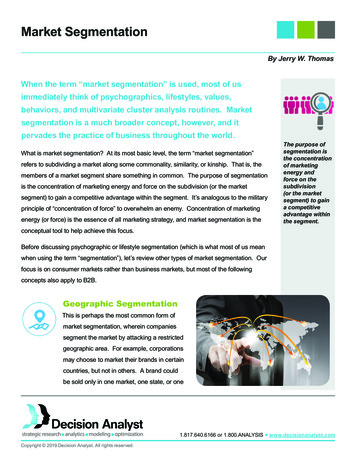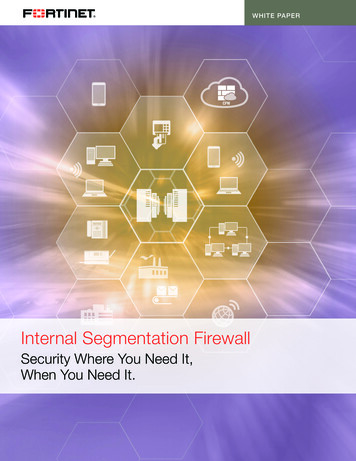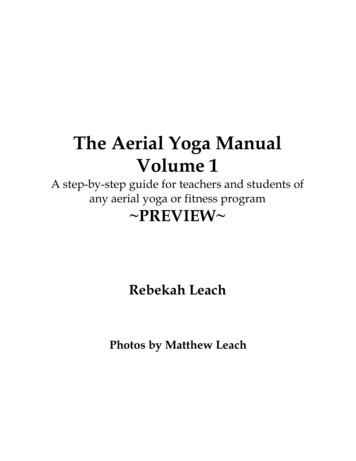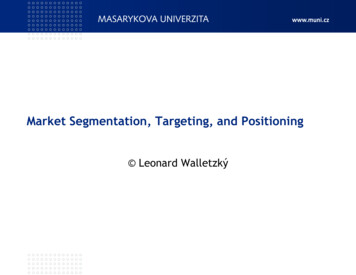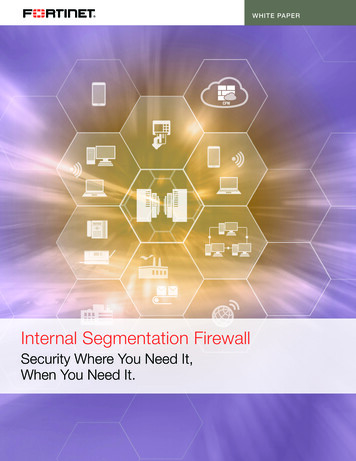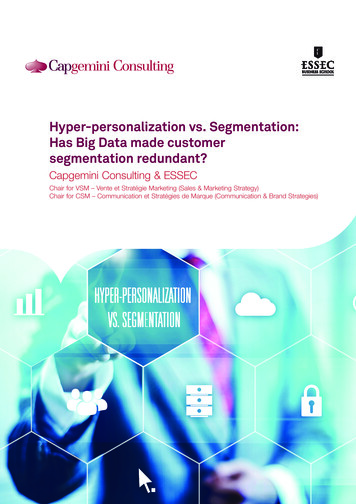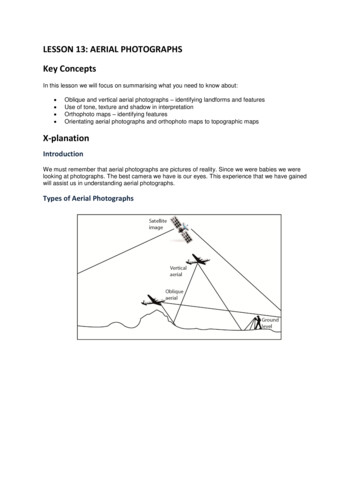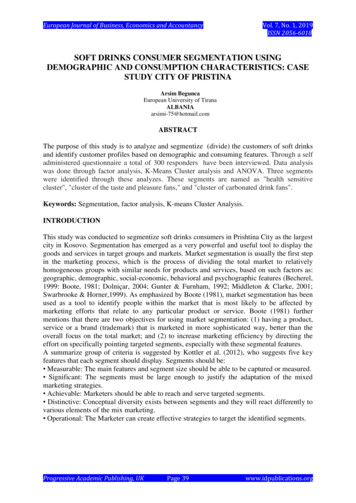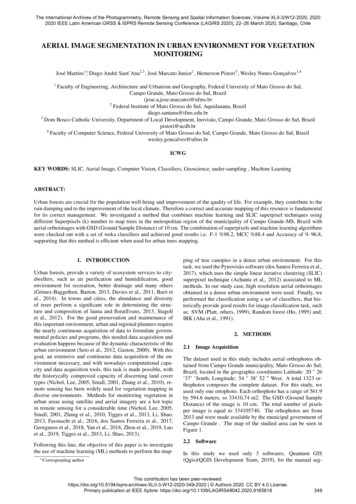
Transcription
The International Archives of the Photogrammetry, Remote Sensing and Spatial Information Sciences, Volume XLII-3/W12-2020, 20202020 IEEE Latin American GRSS & ISPRS Remote Sensing Conference (LAGIRS 2020), 22–26 March 2020, Santiago, ChileAERIAL IMAGE SEGMENTATION IN URBAN ENVIRONMENT FOR VEGETATIONMONITORINGJosé Martins1 , Diego André Sant’Ana2,3 , José Marcato Junior1 , Hemerson Pistori3 , Wesley Nunes Gonçalves1,41Faculty of Engineering, Architecture and Urbanism and Geography, Federal University of Mato Grosso do Sul,Campo Grande, Mato Grosso do Sul, Brazil(jose.a,jose.marcato)@ufms.br2Federal Institute of Mato Grosso do Sul, Aquidauana, Brazildiego.santana@ifms.edu.br3Dom Bosco Catholic University, Department of Local Development, Inovisão, Campo Grande, Mato Grosso do Sul, Brazilpistori@ucdb.br4Faculty of Computer Science, Federal University of Mato Grosso do Sul, Campo Grande, Mato Grosso do Sul, Brazilwesley.goncalves@ufms.brICWGKEY WORDS: SLIC, Aerial Image, Computer Vision, Classifiers, Geoscience, under-sampling , Machine LearningABSTRACT:Urban forests are crucial for the population well-being and improvement of the quality of life. For example, they contribute to therain damping and to the improvement of the local climate. Therefore a correct and accurate mapping of this resource is fundamentalfor its correct management. We investigated a method that combines machine learning and SLIC superpixel techniques usingdifferent Superpixels (k) number to map trees in the metropolitan region of the municipality of Campo Grande-MS, Brazil withaerial orthoimages with GSD (Ground Sample Distance) of 10 cm. The combination of superpixels and machine learning algorithmswere checked out with a set of weka classifiers and achieved good results i.e. F-1 %98.2, MCC %88.4 and Accuracy of % 96.8,supporting that this method is efficient when used for urban trees mapping.1. INTRODUCTIONUrban forests, provide a variety of ecosystem services to citydwellers, such as air purification and humidification, goodenvironment for recreation, better drainage and many others(Gómez-Baggethun, Barton, 2013, Davies et al., 2011, Baró etal., 2014). In towns and cities, the abundance and diversityof trees perform a significant role in determining the structure and composition of fauna and flora(Evans, 2013, Stagollet al., 2012). For the good preservation and maintenance ofthis important environment, urban and regional planners requirethe nearly continuous acquisition of data to formulate governmental policies and programs, this needed data acquisition andevaluation happens because of the dynamic characteristic of theurban environment (Seto et al., 2012, Gaston, 2000). With thisgoal, an extensive and continuous data acquisition of the environment necessary, and with nowadays computational capacity and data acquisition tools, this task is made possible, withthe historycally comproved capacity of discerning land covertypes (Nichol, Lee, 2005, Small, 2001, Zhang et al., 2010), remote sensing has been widely used for vegetation mapping indiverse environments. Methods for monitoring vegetation inurban areas using satellite and aerial imagery are a hot topicin remote sensing for a considerable time (Nichol, Lee, 2005,Small, 2001, Zhang et al., 2010, Tigges et al., 2013, Li, Shao,2013, Fassnacht et al., 2016, dos Santos Ferreira et al., 2017,Georganos et al., 2018, Yan et al., 2018, Zhou et al., 2019, Luoet al., 2019, Tigges et al., 2013, Li, Shao, 2013).Following this line, the objective of this paper is to investigatethe use of machine learning (ML) methods to perform the map Correspondingauthorping of tree canopies in a dense urban environment. For thistask, we used the Pynovisão software (dos Santos Ferreira et al.,2017), which uses the simple linear iterative clustering (SLIC)superpixel technique (Achanta et al., 2012) associated to MLmethods. In our study case, high resolution aerial orthoimagesobtained in a dense urban environment were used. Finally, weperformed the classification using a set of classifiers, that historically provide good results for image classification task, suchas: SVM (Platt, others, 1999); Random forest (Ho, 1995) and;IBK (Aha et al., 1991).2. METHODS2.1Image AcquisitionThe dataset used in this study includes aerial orthophotos obtained from Campo Grande municipality, Mato Grosso do Sul,Brazil, located in the geographic coordinates Latitude: 20 26’37’ ’South, Longitude: 54 38’ 52 ” West. A total 1323 orthophotos composes the complete dataset. For this study, weused only one ortophoto. Each orthophoto has a range of 561.9by 594.6 meters, so 33410,74 m2. The GSD (Ground SampleDistance) of the image is 10 cm. The total number of pixelsper image is equal to 334105740. The orhophotos are from2013 and were made available by the municipal government ofCampo Grande . The map of the studied area can be seen inFigure 1.2.2SoftwareIn this study we used only 3 softwares, Quantum GIS(Qgis)(QGIS Development Team, 2019), for the manual seg-This contribution has been es-XLII-3-W12-2020-349-2020 Authors 2020. CC BY 4.0 License.Primary publication at IEEE Xplore: 9
The International Archives of the Photogrammetry, Remote Sensing and Spatial Information Sciences, Volume XLII-3/W12-2020, 20202020 IEEE Latin American GRSS & ISPRS Remote Sensing Conference (LAGIRS 2020), 22–26 March 2020, Santiago, ChileTable 1. Extractors implemented in PynovisãoExtractorColor StatisticsGray-LevelCoOcurrenceHistogram of OrientedGradientsHu Image MomentsImageMoments(Raw/Central)Local Binary PatternsGabor Filter Bank andK-Curvature AnglesCitation(Swain, Ballard, 1991)(Soh, Tsatsoulis, 1999)(VAN KLAVEREN et al.,1999)(Ming-Kuei Hu, 1962)(Ming-Kuei Hu, 1962)(VAN KLAVEREN et al.,1999)(Feichtinger,Zimmermann,1998)(Abu Bakar et al., 2015)Table 2. Dataset used with classes Background and TreeFigure 1. In the world map, we have to detach Brazil, in green,the state of Mato Grosso do Sul in dark yellow the province ofCampo Grande and in red the metropolitan region of CampoGrande, where the image was obtainedmetation. Pynovisão (dos Santos Ferreira et al., 2017), for theatributes extraction, Superpixels segmentation and classification. Api Rasterio (rasterio.readthedocs.io/en/stable), for theassociation between the manual image notation and the segmentation provided by Pynovisão.2.3Manual image annotationThe orthophoto was uploaded in QGIS software to manuallyannotate the tree canopies. After that, the archive was uploadedto the api rasterio to transform the file into a mask image. Thus,allowing the use of the mask in Pynovisão software to performthe selection of superpixels class.2.4Segmentation process and feature extractionFor the task of mapping the vegetation of urban areas, we adoptthe robust segmentation algorithm: simple linear iterative clustering (SLIC), with different numbers of superpixels (k) configurations, to create the superpixels. The Pynovisão software isused in the majority of the process performed in this work, including the segmentation, feature extraction and classification.In the process of segmentation, using the Pynovisão interface,we are able to search for the best parameters k, which is thenumber of superpixels. To choose the k values that best fitour task, we considered values equal to 3000, 6000 and 9000.Then, based on the mask, these k segments are divided into twoclasses background and Tree. For compactness and sigma, weconsidered the values of 10 and 5, respectively. We reach thisnumber because they make a good representation of the imagecharacteristics and have a multiplier factor between then, making the process a little more intuitive.In the aerial image, the area of the orthophoto representingbackground was much bigger than the tree canopies area resulting in unbalanced dataset. Because of this difference, weperformed an under-sampling (US) process to equalize the knumber of Tree and Background. In this work, we used 3000,6000, and 9000 (unbalanced) and also applied this configuration to under-sampled (UD.) (balanced) datasets.The Pynovisão software performed the extraction of attributeswith the extractors presented in Table 2.SuperpixelsConfiguration (k)3000600090003000 US.6000 US.9000 US.Background segmentsTree ether, these extractors add up to 405 attributes for each superpixel in the dataset. Then, we performed an under-samplingmethod in order to balance the k of background and tree classes.In this way, both classes will have the same k number.2.5ClassifiersIn order to verify the quality of the segmentation processes, aset of Weka classifiers (Hall et al., 2009) was used to classifythe superpixels. For this task we used the classifiers SupportVector Machine (SVM)(Keerthi et al., 2001), K-nearest neighbours classifier (IBK)(Aha et al., 1991) and Random Forest(RF)(Breiman, 2001) with a 10-fold Cross-Validation. For theevaluation, we used the following metrics: F-measure (F1),Matthews correlation coefficient (MCC), and accuracy. Theyallow a more detailed analysis of the results presented in theConfusion matrix. These will be called derivations matrix.2.6HardwareThe operating system used to process the images and segmentation was a Linux Ubuntu 18 and the hardware used for the SLICsegmentation, and the process of training the classifiers (IBK,SVM and Random Forest) had a configuration of motherboardRyzen 7 (1800x); 16GB Ram; 240 GB SSD;Titan Xp (12GB)video card.3. RESULTSThe original image used in the paper can be seen in Figure 2,we can also see the mask created using Rasterio and the QGIStool. The effect in the image of the superpixels segmentationwith SLIC with different k values can be seen in Figure 3. Inthis image, the k values used are 3000, 6000, and 9000.In the confusion matrix presented in Figure 4, we can see theperformance of the three algorithms and 6 configurations. Atthe end of the process, we observe that the classifiers with theThis contribution has been es-XLII-3-W12-2020-349-2020 Authors 2020. CC BY 4.0 License.Primary publication at IEEE Xplore: 0
The International Archives of the Photogrammetry, Remote Sensing and Spatial Information Sciences, Volume XLII-3/W12-2020, 20202020 IEEE Latin American GRSS & ISPRS Remote Sensing Conference (LAGIRS 2020), 22–26 March 2020, Santiago, ChileREAL(a)Original Image(b)M ask ree377833178943SMOFigure 2. Original image(a) and Mask Image created using Qgisand Rasterio(b)IBK77730003000 UD60006000 UD90009000 UDRFFigure 4. The confusion matrix generated by the classifiers withthe different k configurations and balance. The colors illustratethe results of the classification process with blue being thehighest results and red the lowest. The colors are separated bythe k number.F1MCCACCURACYFigure 3. Original image with a detach for a particular region.The impact of different values for k can be verified in theamplified images.Superpixels are in yellowbest results for accuracy were the unbalanced ones, with a result. The SVM achieved a rating of 96.8% for the 3000 unbalanced dataset, and the worst result was 83.3% for IBK the6000 balanced dataset. The complete result of the classificationshowed in the form of a confusion matrix can be seen in Figure4 and Figure 5.The better results are in the unbalanced dataset with a 3000 superpixels and balanced with 6000 superpixels. This result isbetter to understand confusion matrix because it is possible tounderstand where the learning algorithms have many mistakes.In Figures 4 and 5 is possible to see the best results of the unbalanced and balanced experiment. In this case, both learningalgorithms have the best results using an SVM.When comparing the two classes background and tree with themetric f-measure, precision and Recall, we created the table 6,which presents the performance by class, where we can see ,9770,929RF30003000 UDK Number6000and6000 UDbalance90009000 ,7650,860RF30003000 UDK Number6000and6000 UDbalance90009000 ,9590,930RF30003000 UDK Number6000and6000 UDbalance90009000 UDFigure 5. This figure shows the results of the derivations of theconfusion matrix generated in this paper. F1 is the harmonicmean of precision and sensitivity. The Matthews correlationcoefficient (MCC) is used in machine learning as a measure ofthe quality of binary (two-class) classifications, and the accuracyrefers to closeness of the measurements to a specific valuethe F-measure results that the background in general had greaterrelevance than the tree class.In order to evaluate the best technique, we can observe in Figure6, the second step of classifier performance comparison usingF-measure, precision and Recall metrics to show the differencebetween the techniques and to scrutinize better the results wepresent also the, usefulness (precision) and completeness (recall) of the results. Observing the results, we pointed to SVMas the best result with the unbalanced group and the balancedgroup. We have the three models using the unbalanced SVM(SVM (3000K), SVM (6000K) and SVM (6000k)) at the top,side by side, we have three more models with under-sampling(SVM US (3000K), SVM US (6000K) and SVM US (6000k)).However, of these models, the best-unbalanced result was SVMThis contribution has been es-XLII-3-W12-2020-349-2020 Authors 2020. CC BY 4.0 License.Primary publication at IEEE Xplore: 1
The International Archives of the Photogrammetry, Remote Sensing and Spatial Information Sciences, Volume XLII-3/W12-2020, 20202020 IEEE Latin American GRSS & ISPRS Remote Sensing Conference (LAGIRS 2020), 22–26 March 2020, Santiago, Chile(3000k) and SVM US (6000k) for the balanced.would like to thanks NVIDIA Corporation for the donation ofthe GPU used in this research.REFERENCESAbu Bakar, M. Z., Samad, R., Pebrianti, D., Mustafa, M., Abdullah, N. R. H., 2015. Finger application using K-Curvaturemethod and Kinect sensor in real-time. 2nd International Symposium on Technology Management and Emerging Technologies, ISTMET 2015 - Proceeding, 218–222.Achanta, R., Shaji, A., Smith, K., Lucchi, A., Fua, P.,Su sstrunk, S., 2012. SLIC Superpixels. IEEE Transactions onPattern Analysis and Machine Intelligence.Aha, D. W., Kibler, D., Albert, M. K., 1991. Instance-BasedLearning Algorithms. Machine Learning.Baró, F., Chaparro, L., Gómez-Baggethun, E., Langemeyer, J.,Nowak, D. J., Terradas, J., 2014. Contribution of ecosystemservices to air quality and climate change mitigation policies:The case of urban forests in Barcelona, Spain. Ambio.Breiman, L., 2001. Randomforest2001. Machine Learning.Davies, Z. G., Edmondson, J. L., Heinemeyer, A., Leake, J. R.,Gaston, K. J., 2011. Mapping an urban ecosystem service:Quantifying above-ground carbon storage at a city-wide scale.Journal of Applied Ecology.Figure 6. Comparison of Precision, Recall and F-measure bynumber of Superpixels, Balanced and class.dos Santos Ferreira, A., Matte Freitas, D., Gonçalves da Silva,G., Pistori, H., Theophilo Folhes, M., 2017. Weed detection insoybean crops using ConvNets. Computers and Electronics inAgriculture, 143, 314–324.Evans, K. L., 2013. Individual species and urbanisation. UrbanEcology.4. CONCLUSIONSIn this paper, we explored the combination os SLIC superpixeland machine learning methods to segment trees in high resolution aerial imagery. The experiments showed that better resultswere achieved using SVM classifier with 3000 superpixels andunbalanced dataset. The mistakes to classify background is lowbecause the learning algorithms are specialized in its recognition. Also, a reason that the balanced datasets performed worsethan the unbalanced ones is that the under-sampling techniqueexcludes relevant data and valuable information from the original dataset. One of our hypothesis for this is that the background is much more diverse in colors and shapes than the treecanopies. Consequently, more background superpixels are necessary in Pynovisão software.ACKNOWLEDGEMENTSThis study was financed in part by the Coordenação deAperfeiçoamento de Pessoal de Nı́vel Superior - Brasil(CAPES) - Finance Code 001, FUNDECT, Foundation to Support Development of Education, Science and Technology of theState of Mato Grosso do Sul, Brazil and CNPq (National Council for Scientific and Technological Development) through research grants (p. 433783/2018-4 and 314902/2018-0). Thepresent work was also carried out with a research project financed by CAPES through the program Print-CAPES. Also, weFassnacht, F. E., Latifi, H., Stereńczak, K., Modzelewska, A.,Lefsky, M., Waser, L. T., Straub, C., Ghosh, A., 2016. Reviewof studies on tree species classification from remotely senseddata.Feichtinger, H. G., Zimmermann, G., 1998. A Banach spaceof test functions for Gabor analysis. Gabor Analysis and Algorithms, Birkhäuser Boston, Boston, MA, 123–170.Gaston, K. J., 2000. Global patterns in biodiversity.Georganos, S., Grippa, T., Vanhuysse, S., Lennert, M., Shimoni, M., Kalogirou, S., Wolff, E., 2018. Less is more: optimizing classification performance through feature selection ina very-high-resolution remote sensing object-based urban application. GIScience and Remote Sensing.Gómez-Baggethun, E., Barton, D. N., 2013. Classifying andvaluing ecosystem services for urban planning. Ecological Economics.Hall, M., Frank, E., Holmes, G., Pfahringer, B., Reutemann,P., Witten, I. H., 2009. The WEKA data mining software. ACMSIGKDD Explorations Newsletter.Ho, T. K., 1995. Random decision forests. Proceedings of theInternational Conference on Document Analysis and Recognition, ICDAR.This contribution has been es-XLII-3-W12-2020-349-2020 Authors 2020. CC BY 4.0 License.Primary publication at IEEE Xplore: 2
The International Archives of the Photogrammetry, Remote Sensing and Spatial Information Sciences, Volume XLII-3/W12-2020, 20202020 IEEE Latin American GRSS & ISPRS Remote Sensing Conference (LAGIRS 2020), 22–26 March 2020, Santiago, ChileKeerthi, S. S., Shevade, S. K., Bhattacharyya, C., Murthy, K.R. K., 2001. Improvements to Platt’s SMO algorithm for SVMclassifier design. Neural Computation.Zhou, X., Li, L., Chen, L., Liu, Y., Cui, Y., Zhang, Y., Zhang, T.,2019. Discriminating urban forest types from Sentinel-2A image data through linear spectral mixture analysis: A case studyof Xuzhou, East China. Forests.Li, X., Shao, G., 2013. Object-based urban vegetation mappingwith high-resolution aerial photography as a single data source.International Journal of Remote Sensing.Luo, N., Wan, T., Hao, H., Lu, Q., 2019. Fusing high-spatialresolution remotely sensed imagery and OpenStreetMap datafor land cover classification over urban areas. Remote Sensing.Revised November 2019Ming-Kuei Hu, 1962. Visual pattern recognition by moment invariants. IEEE Transactions on Information Theory, 8(2), 179–187. l, J., Lee, C. M., 2005. Urban vegetation monitoring inHong Kong using high resolution multispectral images. International Journal of Remote Sensing.Platt, J., others, 1999. Probabilistic outputs for support vectormachines and comparisons to regularized likelihood methods.Advances in large margin classifiers.QGIS Development Team, 2019. QGIS Geographic Information System.Seto, K. C., Güneralp, B., Hutyra, L. R., 2012. Global forecastsof urban expansion to 2030 and direct impacts on biodiversityand carbon pools. Proceedings of the National Academy of Sciences of the United States of America.Small, C., 2001. Estimation of urban vegetation abundaceby spectral mixture analysis. International Journal of RemoteSensing.Soh, L.-K., Tsatsoulis, C., 1999. Texture analysis of SAR seaice imagery using gray level co-occurrence matrices. IEEETransactions on Geoscience and Remote Sensing, 37(2), 780–795. l, K., Lindenmayer, D. B., Knight, E., Fischer, J., Manning, A. D., 2012. Large trees are keystone structures in urbanparks. Conservation Letters.Swain, M. J., Ballard, D. H., 1991. Color indexing. International Journal of Computer Vision, 7(1), 11–32. s, J., Lakes, T., Hostert, P., 2013. Urban vegetation classification: Benefits of multitemporal RapidEye satellite data.Remote Sensing of Environment.VAN KLAVEREN, E. P.,MICHELS, J. P. J.,SCHOUTEN, J. A., 1999. THE ORIENTATIONALAND STRUCTURAL PROPERTIES OF N 2 and N2 –AR SOLIDS AT HIGH PRESSURE. InternationalJournal of Modern Physics C, 10(02n03), 445–453. 129183199000334.Yan, J., Zhou, W., Han, L., Qian, Y., 2018. Mapping vegetation functional types in urban areas with WorldView-2 imagery:Integrating object-based classification with phenology. UrbanForestry and Urban Greening.Zhang, X., Feng, X., Jiang, H., 2010. Object-oriented methodfor urban vegetation mapping using ikonos imagery. International Journal of Remote Sensing.This contribution has been es-XLII-3-W12-2020-349-2020 Authors 2020. CC BY 4.0 License.Primary publication at IEEE Xplore: 3
AERIAL IMAGE SEGMENTATION IN URBAN ENVIRONMENT FOR VEGETATION MONITORING Jos e Martins 1, Diego Andr e Sant'Ana 2,3, Jos e Marcato Junior 1, Hemerson Pistori3, Wesley Nunes Gonc alves1,4 1 Faculty of Engineering, Architecture and Urbanism and Geography, Federal University of Mato Grosso do Sul, Campo Grande, Mato Grosso do Sul, Brazil (jose.a,jose.marcato)@ufms.br
